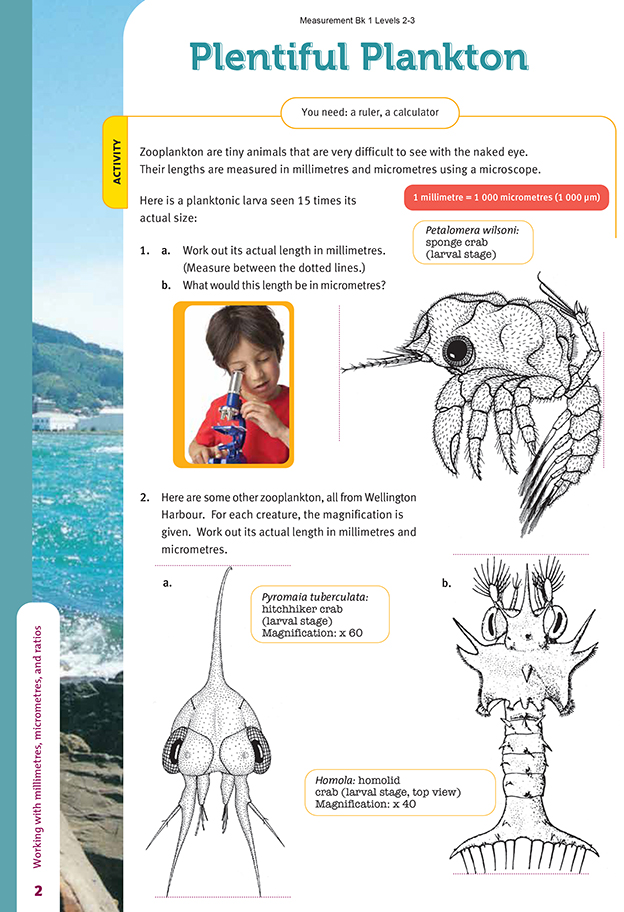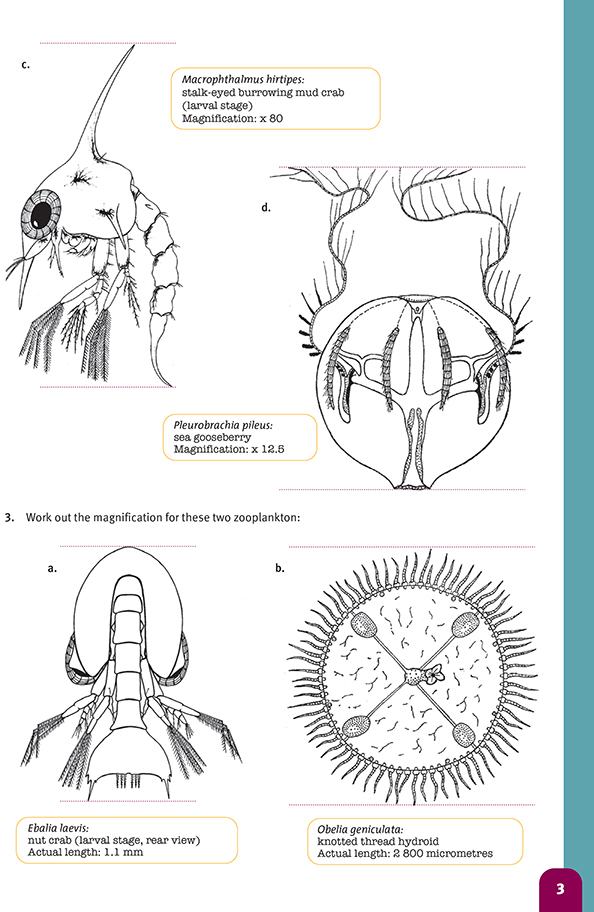This is a level 5 measurement strand activity from the Figure It Out series. It also has an achievement objective from the Level 5 Number strategies and knowledge substrand.
A PDF of the student activity is included.
Click on the image to enlarge it. Click again to close. Download PDF (600 KB)
calculate lengths in millimetres and micrometres
calculate scale factors
FIO, Level 4+, Measurement, Book Two, Plentiful Plankton, pages 2-3
ruler
calculator
In this activity, students calculate the actual size of microscopic creatures from drawings that are highly magnified. Although the words are not used in the students' book, the activity is about enlargement and scale factor as much as it is about measurement.
In questions 1 and 2, the students need to measure the length of the enlarged zooplankton and then divide by the scale factor to get the actual length. They should be able to do this measurement accurate to the nearest millimetre. If they are getting different lengths, you may need to check that they know how to measure the distance between two lines (as distinct from measuring the distance between two points). They must measure at right angles to the lines so that they find the shortest distance between them. Dividing by the scale factor is simply reversing the enlargement process. In question 3, they need to divide the scale length by the actual length to get the magnification.
In each question, the students are asked for lengths in millimetres and micrometres. You could give them this table showing the tidy way in which the metric system deals with the full range of (length) measurement from very large to extremely small:
1 000 picometres = 1 nanometre (1 billionth of a metre) (10-9 metres)
1 000 nanometres = 1 micrometre (1 millionth of a metre) (10-6 metres)
1 000 micrometres = 1 millimetre (1 thousandth of metre) (10-3 metres)
1 000 millimetres = 1 metre The base unit (100 metres)
1 000 metres = 1 kilometre (1 000 metres) (103 metres)
Some students may wish to find out the names for the in-between units. They may also want to find out why, in New Zealand, we do not make much use of terms such as hectometre (100 metres). Most of these units are unnecessary because the measurements can be conveniently expressed using more basic units. Sometimes
one of them is used in a particular context for historical reasons or because it is the ideal unit. For example, you will find the centilitre unit (1 hundredth of a litre) used on all wine bottles, and the hectolitre unit (100 litres) is sometimes used when discussing wine production. Students may also be interested in trying to find out why it is that the US (unlike almost every other country in the world) does not use the metric system.
There are a number of informative websites on this theme.
Cross-curricular links
Science
This activity could lead into a study of the tiny animals around us (such as dust mites) that we are usually unaware of.
Achievement Objectives
- investigate and describe special features of animals or plants which help survival into the next generation (Making Sense of the Living World, level 4)
- investigate, and classify in broad terms, the living world at a microscopic level (Making Sense of the Living World, level 5)
Answers to Activity
1. a. 5.7 mm
b. 5 700 micrometres (µm)
2. a. 1.8 mm or 1 800 µm
b. 2.6 mm or 2 600 µm
c. 1.4 mm or 1 400 µm
d. 8.4 mm or 8 400 µm
3. a. x 75
b. x 30

